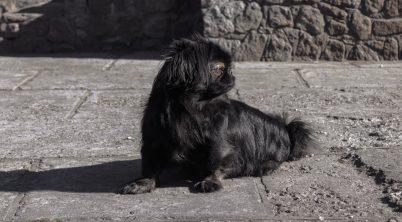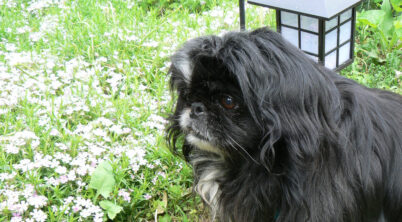The Pekingese, a breed with a storied origin in the imperial courts of China, has long been treasured for its unique appearance and loyal disposition. Regarded as a canine of noble descent, this breed once graced the laps of royalty and was often a symbol of privilege and luxury. Physically distinctive with its flat face, compact body, and luxuriant fur, the Pekingese carries its history with a dignified air befitting its regal lineage.
An essential consideration for the well-being of a Pekingese is maintaining its ideal weight. Historically, these dogs were even classified by size with the particularly tiny ones, known as “sleeve dogs,” being small enough to fit in the capacious sleeves of Chinese imperial garments. In the modern day, the importance of weight is no less significant; a healthy adult Pekingese should typically weigh between 7–14 pounds, a range that supports optimal health and reflects their robust, yet diminutive stature. While individual Pekingeses may vary due to factors like body composition and build, staying within this range is key to ensure longevity and vitality for these esteemed canines.
Table of Contents
Pekingese Ideal Weight
A Pekingese dog typically reaches a healthy weight ranging between 7-14 pounds. This breed is characterized by its compact body and distinct stature, which necessitates maintaining an optimal weight to ensure overall health and well-being.
Male Pekingese Dogs:
- 4-months-old: Approximately 4.3 lbs to 8.4 lbs
Female Pekingese Dogs:
- 4-months-old: Can weigh between 1.5 lbs and 8.0 lbs
As these dogs mature, the weight varies slightly between genders, but an adult Pekingese generally falls into the weight range established by breed standards. It is important to note that the ideal weight reflects not only the size but also the body composition of the Pekingese.
An adult Pekingese’s weight should be proportionate to its size and promote a well-balanced body structure. This breed’s health can be adversely affected by deviations from the ideal weight, making it crucial for owners to monitor their Pekingese’s diet and exercise regimen.
Weight Maintenance for Pekingese:
- Monitor food intake; Pekingeses are prone to obesity
- Ensure regular, moderate exercise
- Regular check-ups with a veterinarian to track weight
If a Pekingese’s weight falls outside of the usual range but the dog appears healthy, consult with a veterinarian. Factors such as individual metabolism and activity levels can cause variations in weight.
Health and Development
The proper weight of a Pekingese is not just a matter of aesthetics; it is closely tied to overall health and developmental milestones. Monitoring weight throughout a Pekingese’s life stages is important for the prevention of health issues.
Growth and Maturity
The Pekingese breed is characteristically muscular and stocky, with a robust growth rate that should be closely observed to ensure the pet remains within a healthy weight range. Physical maturity is typically reached by the age of one, but the dog may continue to fill out and gain muscle until around the age of two.
An adult Pekingese typically weighs between 7-14 pounds, with a growth pattern that should be tracked using a growth chart. Deviations from this weight range can point to underlying health concerns. Obesity can lead to a host of issues, including joint problems, brachycephalic obstructive airway syndrome (BOAS), and an increased risk of diseases like diabetes. Conversely, being underweight may indicate malnutrition or parasitic infections.
As brachycephalic dogs, Pekingeses have distinct facial structures that can make them prone to BOAS. Maintaining an ideal weight is critical for reducing the risk of this and other brachycephalic-related health problems.
Moreover, factors such as neutering or spaying can influence a Pekingese’s metabolism, which should be considered in weight management. A DNA test can sometimes help in anticipating potential growth-related concerns and developing a tailored care plan for the dog’s unique genetic makeup.
Regular veterinary check-ups and a well-balanced diet are key in supporting a Pekingese’s health as it grows and matures. It’s important for owners to be vigilant about their pet’s development and adjust care protocols as necessary.
Nutrition and Diet
Proper nutrition is essential for maintaining the ideal weight of a Pekingese. A balanced diet, appropriate kibble size, and adherence to guidelines are key factors in supporting their health and body condition.
Feeding Guidelines
Adult Pekingese typically require 1/2 to 1 cup of dry food per day, divided into two meals. This portion may vary based on a dog’s size, weight, and activity level. Pet owners should follow the feeding instructions on their dog food packaging, taking into account their pet’s specific needs. For instance:
- Puppies: Smaller, more frequent meals of solid food are necessary to support growth.
- Adults: Two measured meals to maintain stable weight and health.
- Seniors: Possible adjustment in diet to account for lowered activity and metabolism.
Kibble Size: Small breed-specific formulas with appropriately sized kibble help facilitate ease of eating and digestion.
Weight Management
Maintaining the ideal weight for a Pekingese—usually between 7-14 pounds—is crucial. Overfeeding can lead to obesity, which is a common health issue for this breed.
- Monitoring: Regular weigh-ins and observing the body condition can help identify weight gain early.
- Adjustments: If a Pekingese is above the ideal weight range, pet owners should consult a vet for dietary adjustments.
- Exercise: Routine exercise should complement a balanced diet to help manage weight effectively.
Pet owners must be mindful of their Pekingese’s individual needs, making adjustments to diet and exercise as needed to promote optimal health.
Exercise and Training
Maintaining an ideal weight for a Pekingese requires a balance of daily exercise and consistent training. This small breed does not need extensive physical activity but ignoring its exercise needs can lead to weight gain and health issues.
Activity Needs
Pekingese dogs have modest exercise requirements to keep them at a healthy weight. Although they are small in stature, they benefit from daily walks and moderate play. Daily care should involve:
- Leisurely Walks: A short walk twice a day is sufficient for their physical activity needs.
- Playtime: Engage in gentle play to provide mental stimulation and physical health.
- Avoid Overexertion: Due to their brachycephalic (flat-faced) nature, Pekingese can have difficulty breathing, so it’s important not to over-exercise them.
It is essential to monitor their activity to prevent joint issues, as their bones reach full growth and maturity typically by the time they enter adulthood.
Training Techniques
Training a Pekingese can be a unique challenge. They are intelligent but can also be stubborn, which calls for patience and consistency. Effective techniques include:
- Positive Reinforcement: Reward-based training works well, as Pekingese respond to incentives.
- Socialization: Early socialization is important to mitigate potential aggression and to ensure they are well-behaved.
- Regular Practice: Maintain a regular training schedule to establish good habits and prevent behavioral issues.
The key is to keep sessions short and engaging, focusing on their capacity for learning rather than physical exertion. Training also plays an integral role in directing their energy and maintaining an ideal weight throughout their average life span of 12 to 15 years.








